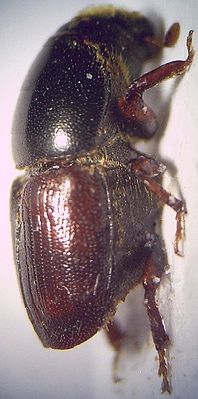Great elm splint beetle
| Great elm splint beetle | ||||||||||||
|---|---|---|---|---|---|---|---|---|---|---|---|---|

Greater elm splint beetle ( Scolytus scolytus ), female |
||||||||||||
| Systematics | ||||||||||||
|
||||||||||||
| Scientific name | ||||||||||||
| Scolytus scolytus | ||||||||||||
| ( Fabricius , 1775) |
The great elm beetle ( Scolytus scolytus ) is a weevil from the subfamily of the bark beetle (Scolytinae). Since it creates its breeding systems in the bark of the host trees, it is counted among the bark breeders.
features
The beetles are 3 to 6 millimeters long and have a cylindrical body. The pronotum is finely dotted mainly on the sides. Seen from above, it does not cover the head. The forehead is flat and without a long keel. The red-brown colored wing covers have two types of rows of dots made up of small depressions. Regular rows of points alternate with rows that only have irregular points. The antennae and legs are red-brown. The beetle is otherwise colored black. The male animal has an outwardly pointed hairbrush on the anal sternite.
distribution
The species is widespread in Europe, in the north it occurs to Sweden.
Way of life
The elm beetle occurs mainly on elms ( Ulmus ), occasionally also on poplars ( Populus ), common ash ( Fraxinus excelsior ), cork oak ( Quercus suber ), hornbeam ( Carpinus betulus ), walnut ( Juglans regia ), Prunus amygdalus and Salix nigra in front. It also colonizes the bark of the trees in the area of the bark . The feeding pattern is a relatively short, two to five, maximum ten centimeters long, one-armed mother tunnel (vertical longitudinal tunnel). The larval ducts branch off laterally from this. Two generations are trained each year. The flight time is from late May to June and late August. The beetles feed on the branches of small branches and on the base of the petioles. In doing so, and when it bores into the bark, it transfers spores of the tubular fungus Ceratocystis ulmi . This fungus, which was introduced to Europe from North America with infected wood in the 1960s, leads to a disease of the tree, elm disease , and usually leads to the death of the host tree.
Combat
Control is practically impossible because the animals will always have material that is suitable for breeding. Infested trees are usually discovered too late. Foci of infestation must be completely eliminated if one wishes to curb further spread and the bark with the larvae and eggs as well as the infected wood destroyed. In many places, however, the elms have already died on the fungus and are therefore no longer available as host trees. There have been attempts to cultivate Resista elms to resist the fungus.
literature
- Fritz Schwerdtfeger : The forest diseases. Textbook of forest pathology and forest protection. 4th, revised edition. Parey, Hamburg / Berlin 1981, ISBN 3-490-09116-7 .
- Sabine Grüne : Handbook for the determination of the European bark beetles. M. & H. Schaper Verlag, Hannover 1979, ISBN 3-7944-0103-4 .
- Edmund Reitter : Fauna Germanica - The beetles of the German Empire. Volume 5, KG Lutz, Stuttgart 1916.
- Edmund Reitter: Fauna Germanica - The beetles of the German Empire. 5 volumes, KG Lutz, Stuttgart 1908–1916, digital library volume 134, Directmedia Publishing GmbH, Berlin 2006, ISBN 3-89853-534-7 .
Web links
Individual evidence
- ↑ Wolfgang Nentwig: Invasive species. Haupt Verlag, Bern 2010, ISBN 978-3-8252-3383-9 , p. 50.